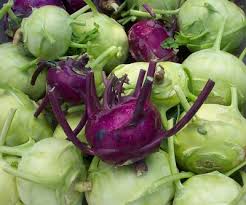 Kohl Rabi is
a tuberous vegetable that is part of the brassica family (along with broccoli,
cauliflower and kale). It has a slightly sweet flavour. It looks and sounds a
little odd, so why would you add to this food?
Kohl Rabi is
a tuberous vegetable that is part of the brassica family (along with broccoli,
cauliflower and kale). It has a slightly sweet flavour. It looks and sounds a
little odd, so why would you add to this food?
Kohl Rabi is
a nutritional power house. It contains only 27 calories per 100grams. In this
100grams only 6 grams of carbohydrates and 4 grams of fibre. This makes it a
very low GI vegetable that’s great for both regulating blood sugar levels and
overall digestive health.
Kohl Rabi is
also nutrient dense, particularly with regards to minerals, being a great
source of calcium, magnesium, iron, potassium and phosphorus, making it particularly
bone friendly. It also contains selenium, and B vitamins. It is also a good
source of vitamin C, with around 62mg per 100g. The leaves or tops of root are
a great source or carotene and vitamin A,
 |
| sciencedaily.com |
A great benefit
of eating Kohl Rabi are the phytochemicals that are present in vegies from the
brassica family, isothiocyanates, sulforaphane, and indole-3-carbinol. Research
suggests these phytochemicals can help reduce the effect of carcinogens on our
cells.
The high
level of nutrients such as carotenes, vitamin A and vitamin C in cruciferous
vegetables provide a great antioxidant profile, and have been shown to be
beneficial in heart disease and stroke, not to mention eye health and skin.
When buying
Kohl Rabi, purchase ones that are less than 8cm width, any large than this and
they could be ‘woody’, also choose ones that are firm with smooth, unwrinkled
skin. Keep it in a cool dark place, leaving it in the fridge could lead it to
go bad more quickly. If stored correctly it should last a week or two at home.
To cook it,
take the top off, chop it up and boil it for up to 10 minutes. Or just throw it
into soups and stews. It’s pretty sturdy and versatile.
So, now you
know why you want to eat it, and how to choose and keep it, but still not sure
what to do with Kohl Rabi? Here are 2 recipes.
Greek Style
Kohl Rabi
Ingredients
Serves 4 as
a starter or snack
•2 small/medium Kohlrabi
•2 pears
•100 g of Feta cheese
•100g salad
leaves
•50g dates
•1 tablespoon honey
•2 tablespoons balsamic vinegar
•2 tablespoons olive oil
Directions
1. Peel the
kohlrabi and chop into dice, about 1cm big.
2. Put the
kohlrabi on a baking tray and drizzle with the olive oil.
3. Bake at
180 C for 20 minutes, or until softened.
4. Slice the
pears in half and cut away the cores. Cut the pears into slices.
5. Put the
salad on a large serving plate and arrange the pear slices and kohl rabi on
top.
6. Crumble
the Feta on top of this.
7. Make the
dressing: Chop the dates and mix with the balsamic vinegar and honey.
8. Drizzle
over the salad.
Kohl Rabi
curry
Ingredients:
Kohlrabi -
3, diced along with the greens
Onion - 1
medium, diced
Garlic - 1
clove, minced
Tomatoes - 2
medium, chopped
Green
chilies - 2, chopped
Tamarind
paste - 1 tbsp.
Jaggery - 1 tsp.
(or to taste)
Red Chili
powder - 1 tsp.
Mustard seeds
- 1/2 tsp.
Cumin seeds
- 1/2 tsp.
Salt - to
taste
Directions
1. Microwave chopped kohlrabi for 5
minutes or until tender. (Pressure cooking works fine too)
2. Heat 1 tbsp. oil in a pan, add the
seeds and after they pop, sauté onions till translucent.
3. Add tomatoes and green chilies; cover
and cook till tender.
4. Add boiled kohlrabi along with the
greens, red chili powder, tamarind paste, jaggery, salt and 1/2 cup of water.
Cover and simmer for about 10 minutes or till the gravy thickens.
Enjoy J